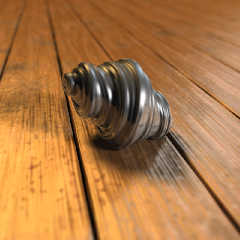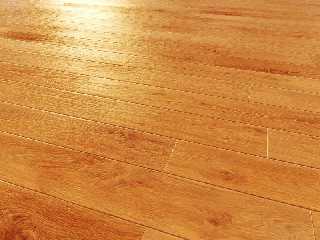 |
 |
|
 |
|
 |
|  |
|  |
|
 |
|
 |
|  |
|  |
|
 |
trace(OBJECT_IDENTIFIER, A, B, [VECTOR_IDENTIFIER]). trace helps you finding the
exact location of a ray intersecting with an object's surface. It traces a ray
beginning at the point A in the direction specified by the vector B. If the ray
hits the specified object, this function returns the coordinate where the ray
intersected the object. If not, it returns <0,0,0>. If a fourth parameter in the
form of a vector identifier is provided, the normal of the object at the
intersection point (not including any normal perturbations due to textures) is
stored into that vector. If no intersection was found, the normal vector is
reset to <0,0,0>.
Add vector identifier to your trace () and you'll get the normal vector back.
Then you can calculate the angle between that and any axis, or the point that
you're tracing from.
Post a reply to this message
|
 |
|  |
|  |
|
 |
From: Sven Littkowski
Subject: Re: INVITATION: Join the Mississippi Paddle-Wheel Steamer!
Date: 7 Apr 2018 21:26:54
Message: <5ac96fde@news.povray.org>
|
|
 |
|  |
|  |
|
 |
Thanks a lot! I copied all information about TRACE for my reference.
Great spirit here in this group!
On 07.04.2018 19:31, Bald Eagle wrote:
> trace(OBJECT_IDENTIFIER, A, B, [VECTOR_IDENTIFIER]). trace helps you find
ing the
> exact location of a ray intersecting with an object's surface. It traces
a ray
> beginning at the point A in the direction specified by the vector B. If t
he ray
> hits the specified object, this function returns the coordinate where the
ray
> intersected the object. If not, it returns <0,0,0>. If a fourth parameter
in the
> form of a vector identifier is provided, the normal of the object at the
> intersection point (not including any normal perturbations due to texture
s) is
> stored into that vector. If no intersection was found, the normal vector
is
> reset to <0,0,0>.
>
> Add vector identifier to your trace () and you'll get the normal vector b
ack.
> Then you can calculate the angle between that and any axis, or the point
that
> you're tracing from.
---
http://www.avg.com
Post a reply to this message
|
 |
|  |
|  |
|
 |
From: Sven Littkowski
Subject: Re: INVITATION: Join the Mississippi Paddle-Wheel Steamer!
Date: 11 Apr 2018 11:47:48
Message: <5ace2e24@news.povray.org>
|
|
 |
|  |
|  |
|
 |
UPDATE
- Continuing to work on the textures or correcting them
- Hunting down mercilessly placement errors I become aware of
This image: the perch that was used for horses or cattle. Still missing:
the food and water troughs, animals, details.
---
Diese E-Mail wurde von AVG auf Viren geprüft.
http://www.avg.com
Post a reply to this message
Attachments:
Download 'sl - mississippi paddle-wheel steamer - perch - 01.jpg' (1197 KB)
Preview of image 'sl - mississippi paddle-wheel steamer - perch - 01.jpg'

|
 |
|  |
|  |
|
 |
From: Sven Littkowski
Subject: Re: INVITATION: Join the Mississippi Paddle-Wheel Steamer!
Date: 12 Apr 2018 02:02:41
Message: <5acef681@news.povray.org>
|
|
 |
|  |
|  |
|
 |
UPDATE
Still working on the textures, and correcting errors as I discover them.
making a good and steady progress, but the days are too short...
---
Diese E-Mail wurde von AVG auf Viren geprüft.
http://www.avg.com
Post a reply to this message
Attachments:
Download 'sl - mississippi paddle-wheel steamer - midships - 02.jpg' (1287 KB)
Download 'sl - mississippi paddle-wheel steamer - perch - 02.jpg' (733 KB)
Preview of image 'sl - mississippi paddle-wheel steamer - midships - 02.jpg'

Preview of image 'sl - mississippi paddle-wheel steamer - perch - 02.jpg'

|
 |
|  |
|  |
|
 |
From: Stephen
Subject: Re: INVITATION: Join the Mississippi Paddle-Wheel Steamer!
Date: 12 Apr 2018 02:45:19
Message: <5acf007f@news.povray.org>
|
|
 |
|  |
|  |
|
 |
On 12/04/2018 07:02, Sven Littkowski wrote:
> UPDATE
>
> Still working on the textures, and correcting errors as I discover them.
> making a good and steady progress, but the days are too short...
>
>
Sorry for the criticism, Sven. The planks of wood look as they have been
cut across the grain. Mostly, the grain should run along the length of
the plank.
--
Regards
Stephen
Post a reply to this message
|
 |
|  |
|  |
|
 |
|
 |
|  |
|  |
|
 |
Stephen <mca### [at] aol com> wrote:
> Sorry for the criticism, Sven. The planks of wood look as they have been
> cut across the grain. Mostly, the grain should run along the length of
> the plank.
> Regards
> Stephen
Right. I don't think he's going to mind that sort of constructive criticism -
so no need to be sorry :)
I was going to point that out as well, and say that the contrasts in the wood
grain and the surface normals need to be much more pronounced. Especially on
the cut ends.
Start with a wood pattern, figure out its orientation, and align your plank with
that.
Then you can translate around in that texture-space to vary the wood grain from
plank to plank. Then you can place that plank in its final location.
It's likely you're going to want certain features in your end product - wisps of
wood sticking up along the corners of rough-sawn lumber, tool marks, wear, dirt,
gouges and tool-marks, nails, pegs, wear from traffic, etc.
I'd say that if you're going to carry all of that through, you're quickly going
to realize that creating and placing all of that by hand for each plank is
impossible - and so you're going to need macros to do that.
Then you may need to overlay the floor as a whole with a mask of some sort to
apply dirt, hay, wear marks, changes in normals and reflectivity, etc.
I'd do those experiments in a small test scene to make it easier to see what
happens up close, keep render times down, and speed up your development.
It's a lot to work on, but if you modularize it so that you can make small
piece-wise changes, it will be manageable. com> wrote:
> Sorry for the criticism, Sven. The planks of wood look as they have been
> cut across the grain. Mostly, the grain should run along the length of
> the plank.
> Regards
> Stephen
Right. I don't think he's going to mind that sort of constructive criticism -
so no need to be sorry :)
I was going to point that out as well, and say that the contrasts in the wood
grain and the surface normals need to be much more pronounced. Especially on
the cut ends.
Start with a wood pattern, figure out its orientation, and align your plank with
that.
Then you can translate around in that texture-space to vary the wood grain from
plank to plank. Then you can place that plank in its final location.
It's likely you're going to want certain features in your end product - wisps of
wood sticking up along the corners of rough-sawn lumber, tool marks, wear, dirt,
gouges and tool-marks, nails, pegs, wear from traffic, etc.
I'd say that if you're going to carry all of that through, you're quickly going
to realize that creating and placing all of that by hand for each plank is
impossible - and so you're going to need macros to do that.
Then you may need to overlay the floor as a whole with a mask of some sort to
apply dirt, hay, wear marks, changes in normals and reflectivity, etc.
I'd do those experiments in a small test scene to make it easier to see what
happens up close, keep render times down, and speed up your development.
It's a lot to work on, but if you modularize it so that you can make small
piece-wise changes, it will be manageable.
Post a reply to this message
|
 |
|  |
|  |
|
 |
From: Sven Littkowski
Subject: Re: INVITATION: Join the Mississippi Paddle-Wheel Steamer!
Date: 12 Apr 2018 11:07:37
Message: <5acf7639$1@news.povray.org>
|
|
 |
|  |
|  |
|
 |
I agree fully. I am still in the process to adjust the texture details.
And I welcome critical opinions, no need to apologize formally. :-)
---
Diese E-Mail wurde von AVG auf Viren geprüft.
http://www.avg.com
Post a reply to this message
|
 |
|  |
|  |
|
 |
From: Sven Littkowski
Subject: Re: INVITATION: Join the Mississippi Paddle-Wheel Steamer!
Date: 12 Apr 2018 11:16:57
Message: <5acf7869@news.povray.org>
|
|
 |
|  |
|  |
|
 |
Yes, all of what you are stating, is true - and already in progress. Hay
- I started to work on a WHILE that places thin yellow cylinders in the
rectangular area of the perch.
My main concern right now, however, is to get the textures right. The
grain visibility of the brown and yellow painted woods is how I want it,
but the directions cause me headache. I might have to develop a texture
for each direction, lots of rewriting. At the moment, the texture is
TRANSLATED randomly to avoid repeating patterns.
Another thing I really want to do is to apply some nice surface
reflections to the lumber, like those you see in these two attached,
wonderful images that are the result of other POV-Ray artists. A
challenge is that since I use a RANDOM TRANSLATE for the wood grain, I
need to apply the same values for the TRANSLATE inside the FINISH
statement. Lots of rewriting...
The deck texture is going to be a real hardship. I want to use a
modified BRICK pattern, where a wood texture is replacing the red brick
texture. That's the easy part and done already. But I also need to find
a way, to randomly TRANSLATE each texture INSIDE each brick to avoid
that the grain continues from brick field to brick field. That's my
challenge now. I opened already, days ago, another thread where I was
talking about this challenge.
---
http://www.avg.com
Post a reply to this message
Attachments:
Download '0007.jpg' (135 KB)
Download 'unnamed.jpg' (111 KB)
Preview of image '0007.jpg'

Preview of image 'unnamed.jpg'

|
 |
|  |
|  |
|
 |
From: Sven Littkowski
Subject: Re: INVITATION: Join the Mississippi Paddle-Wheel Steamer!
Date: 12 Apr 2018 11:54:33
Message: <5acf8139$1@news.povray.org>
|
|
 |
|  |
|  |
|
 |
MACRO Question:
I can declare a double texture this way:
#declare MyTexture =
texture { Texture1 }
texture { Texture2 }
;
But a similar construct seems to be impossible as macro. I tried
successless this:
#macro MyTexture(SomeParameter)
texture { Texture1 }
texture { Texture2 }
#end
Is there any way to create a macro with a double texture?
---
http://www.avg.com
Post a reply to this message
|
 |
|  |
|  |
|
 |
|
 |
|  |
|  |
|
 |
> Is there any way to create a macro with a double texture?
Yes.
> #macro MyTexture(SomeParameter)
> #declare MyTexture =
> texture { Texture1 }
> texture { Texture2 }
> #end
The macro is just a "wrapper" when you invoke a macro, it's just a directive to
tell the POV-Ray parser "and now use the following bit of code [using the
supplied parameters, if any]:"
Post a reply to this message
|
 |
|  |
|  |
|
 |
|
 |
|  |




![]()